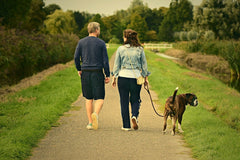
Dogs are not born with patience. They love to run outside as soon as you open the door or jump on their food bowl as soon as you pour their favorite kibble.
Out of the many fun commands you can teach dogs, mealtime manners like teaching a dog to wait feels very rewarding as a pet owner.
Your dog may not know how to wait patiently or even just a few seconds. More self-control can increase your dog's confidence, and most dogs will enjoy short but fun training sessions. Before teaching your dog how to wait for food, it would be helpful to teach them how to sit and stay.
Teaching a dog to "wait" for food

You may be wondering, "how do I teach my dog the wait command" or "what kind of reward to use for training."
In this example, we will teach your dog how to wait by gently pulling away the food bowl if your dog doesn't wait. On the other hand, when your dog waits, we will reward your dog with a treat or a piece of kibble, even if it's just a split second.
Before beginning the training session, ensure that your other pets are kept away and that your dog is calm and hungry. It will be easier to get your dog's full attention. For instance, you may do this training session right before his usual meal time or feeding time.
Follow these steps to train your dog how to wait for food:
Step 1: Add food.
Start with your dog's food bowl filled with a quarter of their dry dog food ration. Hold the food bowl at your waist.
Step 2: Slowly lower the bowl and bring it back up.
Lower the bowl slowly. Bring the bowl back up to your waist if your dog begins to move towards you and the food bowl before you reach knee level.
Step 3: Reward your dog.

As soon as you can reach knee level without your dog moving, reward him with a treat or a piece of kibble. Repeat until your dog is successful two or three times.
Step 4: Aim for lower.
Now that your dog is successful at knee level, repeat the previous steps, but this time, aim for 1 or 2 inches below your knee level.
Reward your dog when he is successful and aim for another couple of inches lower after 2-3 successful attempts. Repeat until you can put the bowl fully on the floor, take your hand away and stand up fully before they eat.
Step 5: Add a cue word.
Once your dog masters waiting for food, consider adding the command word "wait."
They will start associating this command with waiting, and it will help you train your dog to wait before they jump in the car, leave the house, or in any other situations where you would like your dog to wait.
Bonus: Remember the three ways to reward your dog.

Most dog owners think that rewarding a dog means using a training treat, but that's only one of the three main ways to reward dogs.
You can also verbally praise your dog and pet him. Ideally, you may use a combination of all three as it will reward your dog verbally, physically, and through taste.
Teaching a dog to be gentle with treats
It can also be beneficial to teach dogs to be gentle with treats, not just their food bowl. However, one dog training expert said: "when it comes to treats, some dogs are like four-legged sharks!"
Imagine how much your dog's behavior can change for the better once they know how to wait. For example, they may stop jumping on people, on their food, or run outside as soon as you open the door.
Training your pup to wait can be extremely beneficial for a calmer home. On top of that, it may be safer in some situations since your dog will wait for your command before crossing a dangerous road.
Step 1: Place the treat in your hand.
Place the treat in your hand and close your fist completely.
Step 2: Use the "ouch" command.
If your dog tries to grab the food, say, "ouch," and remove your hand from his reach.
Step 3: Repeat until success.
Repeat the previous steps a few times until your dog starts to lick or nibble your hand gently. Then, open your hand, and give the treat.
Working with a resource guarder

Some dogs lack impulse control and are also known to be aggressive around food and their favorite toys. In such instances, dogs can be dangerous and even bite to protect their precious resource.
If you suspect this to be the case, please consider hiring a trainer. However, there is also a way to teach your dog or puppy to share their new toy: the "take it/drop it" cue.
The take it / drop it cue.
Sometimes, dogs are not much different than children, and we need to help them understand the value of sharing, whether it's meals or toys. They will be calmer in general, but this will help lower their anxiety level.
Dogs who lack impulse control often have higher stress levels because they may feel insure. If you teach your dog how to share his food or favorite toy, then you may actually help your dog feel better.
Step 1: Give your dog a toy.
Give your dog a low-value toy, not one of his favorites. Then, ask him to "take it" as he starts to play with it.
Step 2: Present another toy.
After about 30 seconds of playing with the first toy, present another similar value. As your dog drops the first toy, say "drop it," and give him the new one. As he takes the new one, say the "take it" command again.
Step 3: Repeat.
Repeat the previous steps until your dog responds to your "take it" and "drop it" cues. Then, after sufficient practice, begin introducing higher-value toys like his favorite ones.
Additional tips

Let me give you a couple of additional tips so you can teach your dog these new tricks as fast as possible. Dog training requires persistence and may feel frustrating at first. For example, if your dog moves as soon as you reach the bag of kibble, the idea of teaching him to wait before moving towards his food bowl may seem impossible.
However, the benefits of dog training far exceed the time it requires. Imagine the peace of mind whenever going out for a walk and not worrying about seeing your dog pull on the leash or aggressively eating out of your hand—or seeing aggressive behavior in general!
- When you teach your pup waiting, always use positive reinforcement. Yelling or punishing your dog in other ways may increase anxiety in your pup. This is true no matter what dog breed you have.
- Sometimes, you will need a lot of patience for dog training. Practice repeatedly, even for just a couple of minutes at a time, and you will soon reap the benefits. Prepare yourself to bend up and down a lot.
- Always end training on success. Once your pup achieves the step, you may consider ending the session there and try again later or the next day. If your dog looks unhappy, frustrated, or confused, you may consider ending the session.



